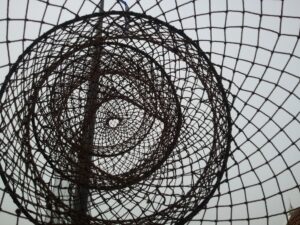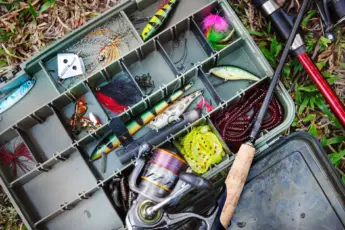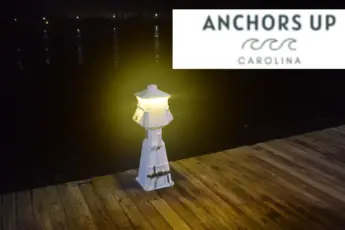Let’s face it; fishing is an expensive sport. The combination of buying gear, hooks, weights, floats, and other items adds up at a rapid rate. Factor in purchasing bait on a weekly basis. You can eliminate the cost of bait by investing in fishing traps. Fishing traps allow you to catch your bait. I have compared purchasing a bait trap to purchasing bait weekly. With that being said, if you buy bait only five times per year, the trap would be paid off. Here is what you need to know about pinfish traps.
Do Pinfish Traps Work
Without a doubt, when baited and deployed in the proper area, pinfish traps yield results.
The coastal waters of Georgia, South Carolina, and North Carolina are loaded down with pinfish. Therefore, it won’t be due to a population concern but rather if you’re correctly deploying the trap. Look, I have to say it, but you won’t catch pinfish in freshwater as they are a saltwater species.
Without a doubt, the traps are highly effective. The trap is a metal wire frame that is submerged in vinyl. To explain, the vinyl coating reduces the risk of oxidation, thus increasing the lifespan.
Central of the enclosure is a bait holder. Depending on the model, a cone shaped opening is on one or both sides, allowing the pinfish to swim inside but not back out.
What Kind Of Bait Do You Use For A Pinfish Trap
Bait is an essential factor in attracting pinfish to swim inside the enclosure. Without the proper bait, you’re wasting your time. Conversely, the options are extensive, so don’t worry about finding something effective.
First off, you’re likely using pinfish to catch bigger fish. Therefore, don’t toss the filleted fish carcasses back into the water. Instead, place them in the trap. Additionally, freeze the carcasses and use them at a later date if you’re not planning to fish shortly.
Secondly, dog food also attracts pinfish into traps. Dog food is highly scented and oily. Therefore the scent of the fat travels through the water. Pinfish from afar are drawn closely to traps.
Here is what I don’t recommend. While shrimp and squid are well scented to lure in pinfish, they quickly deteriorate. As a result of the deterioration, the bait inside the trap will break down and exit even the smallest openings. Therefore, you are unlikely to catch as many baitfish.
How Long Do You Leave A Pinfish Trap
Timing is critical when it comes to setting one or more traps. Importantly, determine when you will be heading out fishing. For example, if you plan to fish on a Saturday morning, the trap must have sat in the water for up to 24 hours to maximize results.
Twenty-four hours is the general rule of thumb for setting pinfish traps, similar to blue crab traps. When you arrive back at the trap, remember to bring along a bucket and aerator pump, or your bait will be dead by the time you cast a line.
Unfortunately, I have fallen victim to having traps stolen. In obvious areas, other anglers assume traps are abandoned. Therefore, move or remove the trap at the 24 hour mark to reduce the risk of theft.
How Long Will Pinfish Survive In A Trap
The point of live bait of fishing them live. Eventually, the fish will die when the food runs out in the trap from letting it sit for extended periods.
Not only do you not want to kill fish unnecessarily, but you are at risk of pulling up decaying carcasses that stink.
Without a doubt do not allow the trip to sit for any time greater than 48 hours. If you’re fishing plans change or the weather doesn’t cooperate, pull the trap and reset it another day.
How To Hold A Pinfish Trap On The Bottom
Pinfish live in tidal waters; therefore, the water moves regularly except for slack tide. In fact, I regularly catch pinfish in saltwater lagoons, where the water rushes in as the tide rises. Trust me, the flow of water is fast. With that being said, even with bait inside the trap it is likely to drift in the currents. To prevent drifting a weight is necessary.
Adding a deep dropping weight is one of the most effective methods to hold a pinfish trap on the bottom of the seafloor. The weights typically range from five to eight pounds. Don’t attempt to use small fishing leads, as they will slip between the openings in the trap.
Importantly, always secure the trap to a fixed object on the shoreline or add a float to a line affixed to the trap.
Alternative Methods For Catching Pinfish
Although more time consuming than deploying a trap or throwing a cast net is using a rod and reel to catch pinfish.
Similarly to deploying traps, focus on highly vegetated areas, pilings, or oyster beds.
With a light weight spinning rod, dd a 2/0 or 3/0 circle hook one or two feet beneath a small float, depending on the depth of the water.
I have caught many pinfish and can attest to the fact that they are bait thieves. While small pieces of shrimp are effective cut squid is ideal. Cut squid is challenging for a pinfish to pull free from a hook.
Avoid leaving the fish out of the water for extended periods or injuring the fish while removing the hook. The goal, remember is to fish a highly active bait. Once the hook is removed, quickly add it to the bait bucket or livewell.
Save Money Use a Pinfish Trap
Make the initial investment of buying a trap instead of shelling out money weekly. Remember, take care of the trap. Rinse it with fresh water after every use. Importantly, use caution when handling pinfish. Pinfish are called pinfish for a reason the dorsal fin is lined with sharp barbs. I recommend wearing gloves when handling pinfish. You’ll have a bucket full of live bait when using a pinfish trap.






